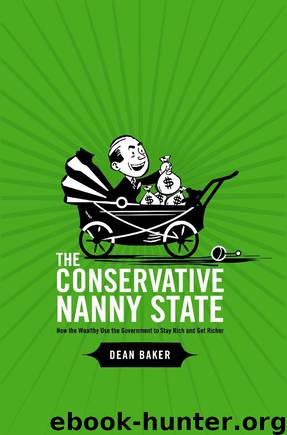The Conservative Nanny State: How the Wealthy Use the Government to Stay Rich and Get Richer by Dean Baker

Author:Dean Baker [Baker, Dean]
Language: eng
Format: epub, mobi
Tags: Business & Economics, Economic Conditions, Economics, Macroeconomics, History, General
ISBN: 9781411693951
Google: i_jyKcVbCw0C
Amazon: 1411693957
Publisher: LULU
Published: 2006-07-15T07:00:00+00:00
13 These data are taken from the Center for Medicare and Medicaid Services (2006, Table 11).
14 This estimate is derived in Baker (2005a).
54
would eliminate the incentive to make duplicative programs and applications
that were not qualitatively better than existing programs and applications.
Textbooks present another situation in which the mechanism of copyright
financed production does not seem to be leading to good results. Textbook
prices have been rising at the rate of 6 percent a year since the late eighties, approximately 3 percentage points more rapidly that the overall rate of inflation.
The incentives created by copyright monopolies encourage textbook publishers to constantly adapt their books to persuade faculty to use new editions, even when the research in the area provides little reason to change a textbook. This
quickly makes used editions obsolete.
In addition, textbook publishers practice the same sort of price
discrimination as pharmaceutical companies, charging lower prices in Europe
and developing countries than they do in the United States. To preserve this type of price discrimination, the textbook publishers, like the drug companies, rely on the nanny state to police their marketing arrangements. They want the government to arrest people who sell their books at the wrong price in the
wrong place, since large price differences cannot persist in a truly free market.
It would be a simple matter to establish a small pool of public money to
contract with publishers to produce textbooks. As with prescription drugs, all the textbooks produced with public funds would be in the public domain and
freely available over the Internet.15 A pool of $300 million a year would be sufficient to produce 3,000 textbooks a year, assuming an average cost of
$100,000 each. (Presumably, some textbooks would cost considerably more than $100,000 to produce, and some would cost less, depending on their length, subject matter, and quality.) Since all of these textbooks would be available over the Internet, college students could save the $12 billion they currently spend on textbooks, minus whatever amount they spend printing out segments of the
books in hardcopy. This alternative mechanism would also have the benefit of allowing professors to mix and match sections from different textbooks, instead of being largely bound to rely on a single textbook for an entire course.
Of course, this alternative system could exist side-by-side with the existing copyright financed system. If professors felt that the publicly financed system was not producing worthwhile textbooks, then they would be free to assign a
textbook supported by copyright, and sold at copyright protected prices, just as they do now.16 There is no reason not to experiment with various paths.
Certainly pluralistic solutions pose no problem for publicly financed research and creative work.
Using Vouchers to Combat Copyright Monopolies
When it comes to music, movies, books, and other forms of creative work,
most of us do not want some government czar of culture and information
Download
The Conservative Nanny State: How the Wealthy Use the Government to Stay Rich and Get Richer by Dean Baker.mobi
This site does not store any files on its server. We only index and link to content provided by other sites. Please contact the content providers to delete copyright contents if any and email us, we'll remove relevant links or contents immediately.
International Integration of the Brazilian Economy by Elias C. Grivoyannis(91925)
The Radium Girls by Kate Moore(11930)
Turbulence by E. J. Noyes(7942)
Nudge - Improving Decisions about Health, Wealth, and Happiness by Thaler Sunstein(7622)
The Black Swan by Nassim Nicholas Taleb(7016)
Rich Dad Poor Dad by Robert T. Kiyosaki(6414)
Pioneering Portfolio Management by David F. Swensen(6230)
Man-made Catastrophes and Risk Information Concealment by Dmitry Chernov & Didier Sornette(5926)
Zero to One by Peter Thiel(5691)
Secrecy World by Jake Bernstein(4652)
Millionaire: The Philanderer, Gambler, and Duelist Who Invented Modern Finance by Janet Gleeson(4386)
The Age of Surveillance Capitalism by Shoshana Zuboff(4216)
Skin in the Game by Nassim Nicholas Taleb(4165)
Bullshit Jobs by David Graeber(4101)
The Money Culture by Michael Lewis(4083)
Skin in the Game: Hidden Asymmetries in Daily Life by Nassim Nicholas Taleb(3935)
The Dhandho Investor by Mohnish Pabrai(3706)
The Wisdom of Finance by Mihir Desai(3659)
Blockchain Basics by Daniel Drescher(3511)
